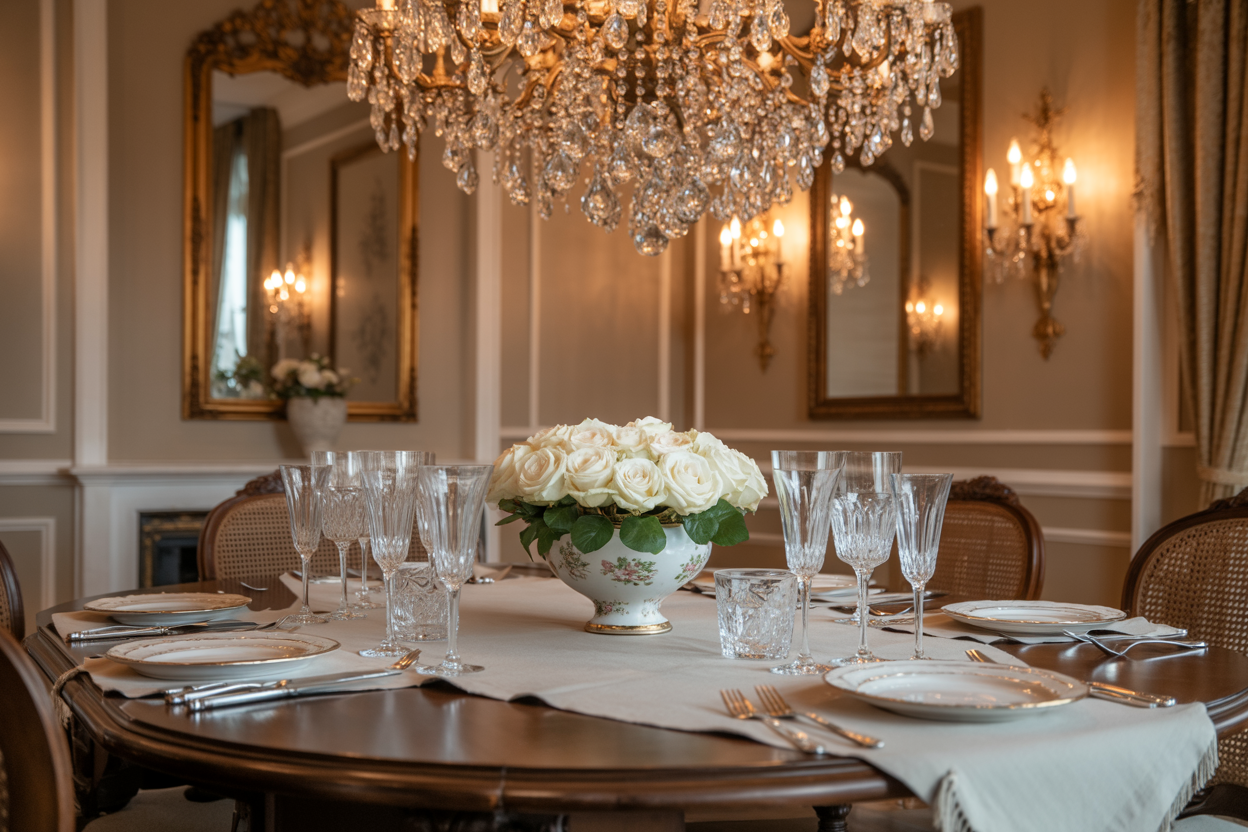
The dining room lighting in your home might be silently sabotaging the upscale atmosphere you’ve worked so hard to create. While you’ve invested in quality furniture, elegant table settings, and carefully chosen artwork, poorly selected lighting fixtures can instantly transform your sophisticated space into something that feels more like a cafeteria than a luxury dining experience.
In order to come up with the very specific design ideas, we create most designs with the assistance of state-of-the-art AI interior design software.
Understanding which lighting choices undermine your home’s luxury appeal is the first step toward creating the refined ambiance your dining room deserves. From overdramatic chandeliers that overwhelm the space to harsh fluorescent tubes that make every meal feel like an interrogation, the wrong lighting decisions can undo thousands of dollars worth of thoughtful design work. The good news is that once you recognize these common missteps, you can make targeted improvements that will elevate your dining room from ordinary to extraordinary.
30. Over-glittery fixtures doing all the heavy lifting, leaving the rest of the room flat.
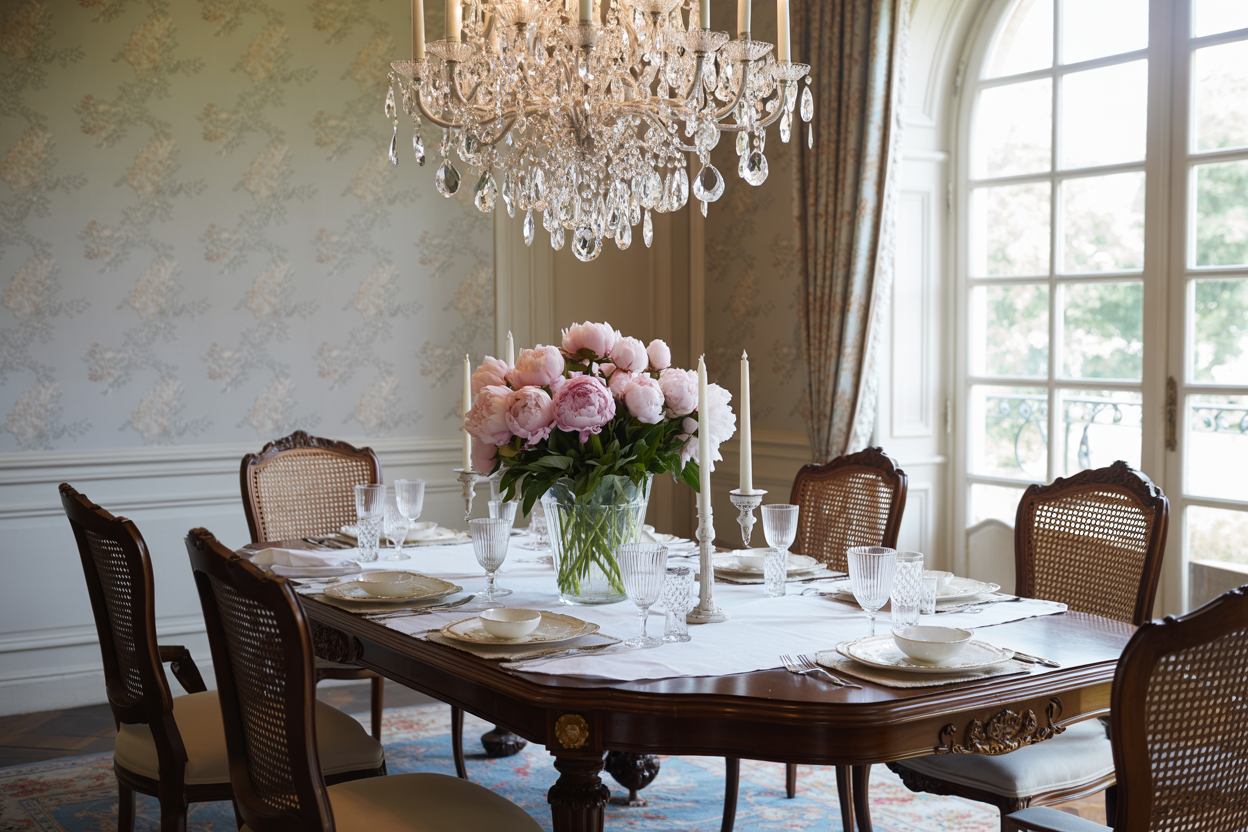
You know that chandelier you fell in love with at the showroom? The one dripping with crystals that caught every light beam like a disco ball? It’s probably working overtime while your dining room looks like a sad afterthought.
When your fixture is the only star in the room, everything else fades into darkness. Your beautiful wall art becomes invisible. That gorgeous sideboard you spent months hunting for? It’s sitting in shadows.
This approach creates what designers call “spotlight syndrome.” One brilliant focal point surrounded by a black hole of nothingness. Your guests will admire the chandelier for thirty seconds, then spend the evening squinting at each other across a poorly lit table.
The real luxury comes from layered lighting that includes ambient, accent, and task lighting. Your statement piece should work with wall sconces, buffet lamps, or subtle recessed lighting.
Think of your glittery fixture as the lead singer, not a one-person show. It needs backup dancers to create the full performance. Without supporting light sources, even the most expensive chandelier becomes a lonely spotlight in an otherwise forgettable room.
29. Bulky, oversized fixtures overwhelming minimalist decor

Your minimalist dining room doesn’t need a chandelier the size of a small planet. Yet homeowners consistently choose massive fixtures that completely destroy the clean, serene aesthetic they’re trying to achieve.
Minimalist lighting design requires restraint and thoughtful selection. When you hang a bulky fixture over your sleek dining table, you’re essentially putting a wrestling match between your lighting and your decor.
The beauty of minimalism lies in its simplicity and breathing room. Your oversized fixture becomes a visual anchor that weighs down the entire space instead of enhancing it.
Modern minimalist lighting should complement your clean lines, not compete with them. Choose fixtures with slim profiles and geometric shapes that maintain the uncluttered feel.
Remember, bigger isn’t always better in minimalist spaces. Your dining room lighting should whisper elegance, not shout for attention.
Consider pendant lights with clean silhouettes or linear fixtures that follow your table’s proportions. The goal is creating harmony between your lighting and your carefully curated minimalist aesthetic.
28. Mixing lighting temperatures in one space, causing visual confusion

Your dining room’s lighting temperature consistency matters more than you might think. When you combine warm 2700K bulbs with cool 4000K fixtures in the same space, you create an unsettling visual discord that screams amateur hour.
The human eye notices these temperature clashes immediately. Your chandelier might cast a cozy amber glow while your recessed lights beam stark white light across the table. This jarring contrast makes your carefully curated space feel disjointed and cheap.
Mixing lighting temperatures in one room could work if you do it carefully, but most homeowners lack the expertise to pull it off successfully. The result is often visual chaos rather than sophisticated layering.
Different color temperatures confuse your guests’ perception of the space. Food looks unappetizing under mixed lighting, and your dining room’s ambiance suffers dramatically.
Luxury spaces maintain consistent temperature ranges throughout. Your 3000K pendant lights should match your 3000K wall sconces for a cohesive, high-end appearance.
Color temperature affects not only the aesthetic of a room but also the ambiance and functionality. Stick to one temperature family to maintain that expensive, professionally designed look you’re after.
27. Poor placement of lights causing shadows on diners’ faces

Nothing kills the luxury dining experience quite like your guests looking like they’re auditioning for a horror movie. When you place lights directly overhead, you’re essentially creating a spotlight that casts unflattering shadows under everyone’s eyes and nose.
The problem gets worse when you rely on a single central fixture. Your beautiful chandelier might look stunning, but if it’s the only light source, half your dinner party will be sitting in shadows while the other half squints from glare.
Lighting placement experts warn against installing overhead lights directly above heads, as this creates harsh shadows that make even your most attractive friends look ghoulish.
Smart designers know to position fixtures to the side of the table or use multiple fixtures spaced evenly throughout the room. This approach eliminates those dramatic shadows that make your dining room feel more like an interrogation chamber than a luxury space.
Consider wall sconces or strategically placed table lamps to provide side lighting. This creates even illumination across faces, maintaining that upscale ambiance you’ve worked so hard to achieve.
26. Choosing outdated swag lamps that look like leftovers from Grandma’s house

Those hanging swag lamps from the 1970s might trigger warm memories of Sunday dinners at Grandma’s house, but they’re absolutely crushing your dining room’s luxury potential. You know the ones – those tethered ceiling fixtures with their dated chains and overly ornate shades.
Swag lamps became popular in the 60s and 70s for good reason back then. They were economical and versatile. But hanging onto these relics today makes your dining space look like a time capsule nobody asked for.
The biggest problem isn’t just their age – it’s how they instantly cheapen the entire room’s aesthetic. Those heavy, overly decorative lampshades and visible cords create visual clutter that fights against any attempt at sophisticated design.
Your guests will notice that outdated fixture before they see your beautiful dining table or carefully chosen artwork. These tethered ceiling lamps might offer practical lighting, but they’re working against every other design choice you’ve made.
Modern luxury dining rooms demand cleaner lines and more refined lighting solutions.
25. The dreaded ‘single chandelier’ solution without secondary lighting for balance.

You’ve installed that stunning chandelier over your dining table and called it a day. Big mistake. One fixture, no matter how expensive, creates harsh shadows and unflattering lighting that screams amateur hour.
Your guests’ faces disappear into dramatic shadows while they’re trying to enjoy dinner. The chandelier becomes a spotlight instead of ambient lighting, making everyone look like they’re being interrogated rather than entertained.
Professional designers know that layered lighting approaches create depth and sophistication. You need wall sconces, recessed lights, or table lamps to fill in those harsh shadows your chandelier creates.
The single-fixture approach also leaves your dining room feeling flat and one-dimensional. Without secondary lighting sources, you can’t adjust the mood or create intimate conversations during different parts of the evening.
Smart homeowners add dimmer switches and multiple light sources to create flexibility. Your chandelier should be the star, not the only performer in the lighting show.
This lazy approach to lighting design instantly telegraphs that you don’t understand luxury design principles. True elegance comes from thoughtful layering, not expensive single purchases.
24. Harsh fluorescent tubes hanging over the table like interrogation lights
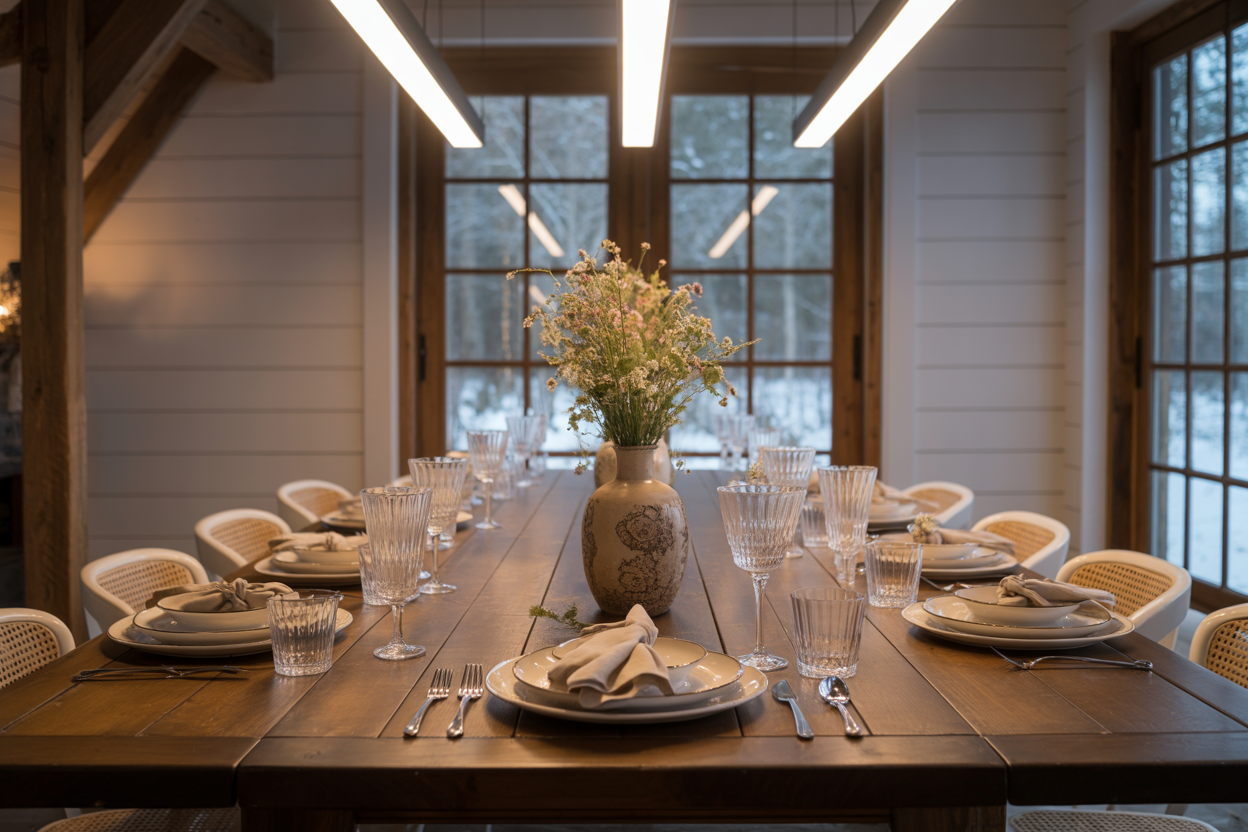
Nothing screams “luxury dining experience” quite like feeling you’re about to be questioned by detectives. Yet somehow, harsh fluorescent tubes keep finding their way into dining rooms across America.
These industrial fixtures cast that unflattering, cold light that makes your beautiful hardwood table look like it belongs in a dimly lit, claustrophobic interrogation room. Your guests will feel like they’re dining in a hospital cafeteria rather than your carefully curated space.
The buzzing sound alone destroys any ambiance you’ve worked to create. Add the greenish tint that makes everyone look seasick, and you’ve successfully transformed dinner into an endurance test.
Fluorescent lighting eliminates shadows and warmth completely. Every imperfection becomes magnified under this unforgiving glare.
Your dining room deserves better than this institutional nightmare. Save the fluorescents for your garage workshop where they belong.
23. Ignoring fixture material quality – plastic fittings over solid brass or bronze

You can spot a cheap dining room fixture from across the room. The telltale signs are usually plastic components masquerading as metal.
Quality light fixtures feature solid metals like brass or stainless steel. Your guests will notice the difference immediately when they see flimsy plastic chain covers or mounting hardware.
Brass has higher malleability and fluidity, making it excellent for detailed fixture work. The warm patina develops character over time rather than looking cheap.
Bronze fittings are stronger and more durable than brass, offering superior corrosion resistance. This makes them ideal for dining rooms with higher humidity from cooking activities.
Plastic components crack, discolor, and break down under heat from bulbs. They scream “builder grade” louder than a smoke detector at 3 AM.
Your dining room deserves hardware that ages gracefully. Invest in solid metal fittings that will still look elegant decades from now.
22. Inappropriate fixture size: tiny light fixtures in a grand space

Nothing screams “amateur hour” quite like a petite chandelier hanging forlornly in a cathedral-ceilinged dining room. It’s like wearing a child’s bowtie to a black-tie event.
Your grand dining space deserves lighting that matches its ambitions. When you install a fixture that’s too small, it creates an awkward visual imbalance that makes even the most expensive furnishings look cheap.
The problem with choosing the wrong size light fixture is that it throws off the entire room’s proportions. Your eye immediately notices something’s wrong, even if you can’t pinpoint what.
For larger rooms with high ceilings, you need to fill the space with larger lighting fixtures. A tiny pendant light in a grand space looks lost and insignificant.
The right size chandelier complements the room’s dimensions and creates visual harmony. When your fixture is properly sized, it becomes a commanding focal point rather than an afterthought.
Your dining room’s luxury potential dies when oversized spaces are paired with undersized lighting. Scale matters in design, and getting it wrong is a dead giveaway of inexperience.
21. Cheap drum pendants lacking depth and texture

Basic drum pendant lighting from big box stores screams budget compromise. These flat, uninspiring fixtures hover over your dining table like sad fabric cylinders.
Quality drum pendants feature layered materials and dimensional details. Cheap versions use thin fabric stretched over wire frames with zero visual interest.
The fabric on bargain drums often appears translucent and flimsy. When illuminated, they reveal every structural wire and mounting hardware underneath.
Luxury dining spaces demand pendants with substance. Look for drums with dual-layer shades, textured weaves, or interesting patterns that create visual depth.
Proper drum pendant placement requires fixtures substantial enough to anchor your dining area. Cheap versions disappear into the background instead of commanding attention.
Your guests notice quality materials immediately. Thin fabric shades that buckle or sag under their own weight destroy any upscale ambiance you’ve worked to create.
Quality drum pendants incorporate mixed materials like metal accents, wood trim, or interesting hardware. Budget versions skip these details entirely, leaving you with boring fabric tubes that cheapen your entire space.
20. Ignoring the importance of warm dimmable LEDs mimicking candlelight.

Your dining room’s lighting is sabotaging every luxury detail you’ve carefully curated. Standard dimmable LEDs maintain their harsh color temperature when dimmed, creating an uninviting atmosphere that screams “office cafeteria” rather than “intimate dinner party.”
The magic happens when you invest in warm dim LED technology that shifts toward warmer tones as brightness decreases. These specialized bulbs mimic how incandescent bulbs naturally become more golden when dimmed, creating that coveted candlelight effect.
Philips LED bulbs with “Warm Glow” technology excel at replicating this natural color shift. They transform your dining space from sterile to sophisticated with the simple turn of a dimmer switch.
The difference is striking during evening meals. Regular LEDs maintain their cool blue undertones even at low brightness, making food look unappetizing and faces appear washed out.
Professional warm dim LEDs can transition down to 2200K, matching the warm glow of actual candles. This small upgrade instantly elevates your dining room’s ambiance from amateur to restaurant-quality sophistication.
19. Overusing colored bulbs that turn everything into a weird Instagram filter

You know those colored LED bulbs that seemed like such a fun idea? They’re turning your elegant dining room into a disco nightmare that would make even the most popular Instagram effects cringe.
Purple light makes your guests look like they’re dying. Blue creates an underwater morgue effect that kills any appetite. Red turns dinner into a haunted house experience.
Your beautiful mahogany table becomes unrecognizable under green lighting. That expensive crystal chandelier you invested in? It loses all its sparkle under artificial color.
Smart bulbs with color-changing features belong in teenagers’ bedrooms, not sophisticated dining spaces. The constant shifting between colors creates visual chaos that destroys any sense of luxury you’ve worked to build.
Warm white or soft white bulbs create the timeless elegance you’re actually after. They enhance natural wood tones, make food look appetizing, and flatter everyone’s complexion.
Save the colored lighting for your basement game room or outdoor patio parties. Your dining room deserves better than looking like a filtered Instagram story gone wrong.
18. Pendant lights that dominate the space and kill conversation flow
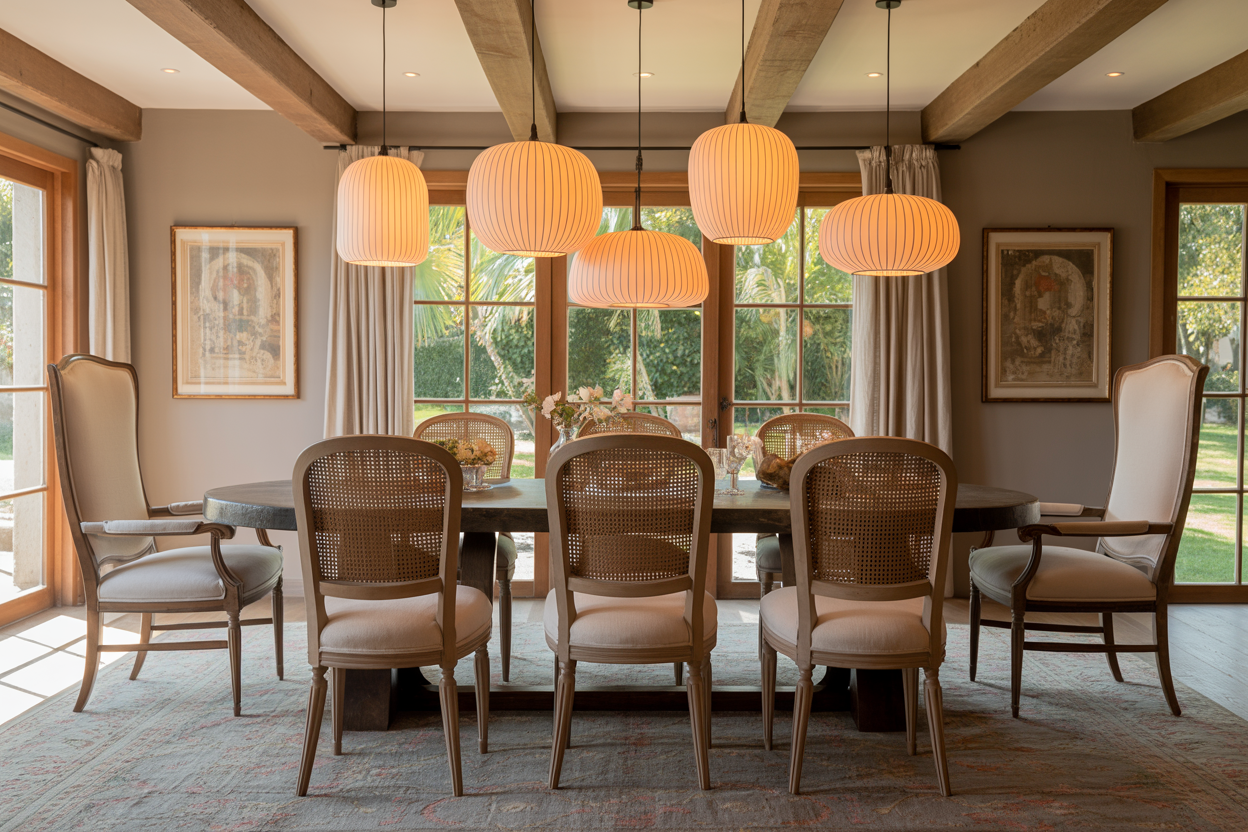
Your dining room isn’t a showroom for lighting fixtures. When pendant lights become the star of the show, they’ve crossed the line from functional to obnoxious.
Oversized pendants hanging too low create visual barriers between dinner guests. You’re essentially installing conversation blockers above your table.
The worst offenders are those massive multi-light fixtures that sprawl across the entire dining space. They fragment the room and make intimate dinner conversations feel like shouting matches across a construction site.
Modern pendant lighting should complement your space, not consume it. When guests spend more time looking at your light fixture than engaging with each other, you’ve missed the mark entirely.
Multiple pendants clustered together create a busy, chaotic feeling that destroys any sense of calm sophistication. Your dining room starts resembling a restaurant kitchen more than a luxury home.
The goal is ambient lighting that enhances conversation, not sculptural statements that interrupt it. Save the dramatic lighting installations for your foyer where they won’t interfere with human connection.
17. Unbalanced lighting where one side of the room is a lighthouse, the other a cave

Nothing screams amateur hour quite like a dining room where your guests need night vision goggles to see their salad while being blinded by a spotlight on the other side. This uneven distribution of light makes the room feel unbalanced and frankly awkward.
You’ve probably seen this disaster in action. One corner blazes with harsh overhead lighting while the opposite side lurks in shadows darker than your morning coffee.
The fix involves creating layered lighting from multiple sources rather than relying on a single fixture. Think of it as painting with light rather than attacking your room with a floodlight.
Getting light from only one direction will kill a room. Your dining space needs light coming from different angles to soften shadows and create visual balance.
Add table lamps, wall sconces, or pendant lights to distribute illumination evenly. Your guests will thank you for not requiring them to choose between squinting and stumbling.
16. Cheap globes that look like dollar store clearance items.
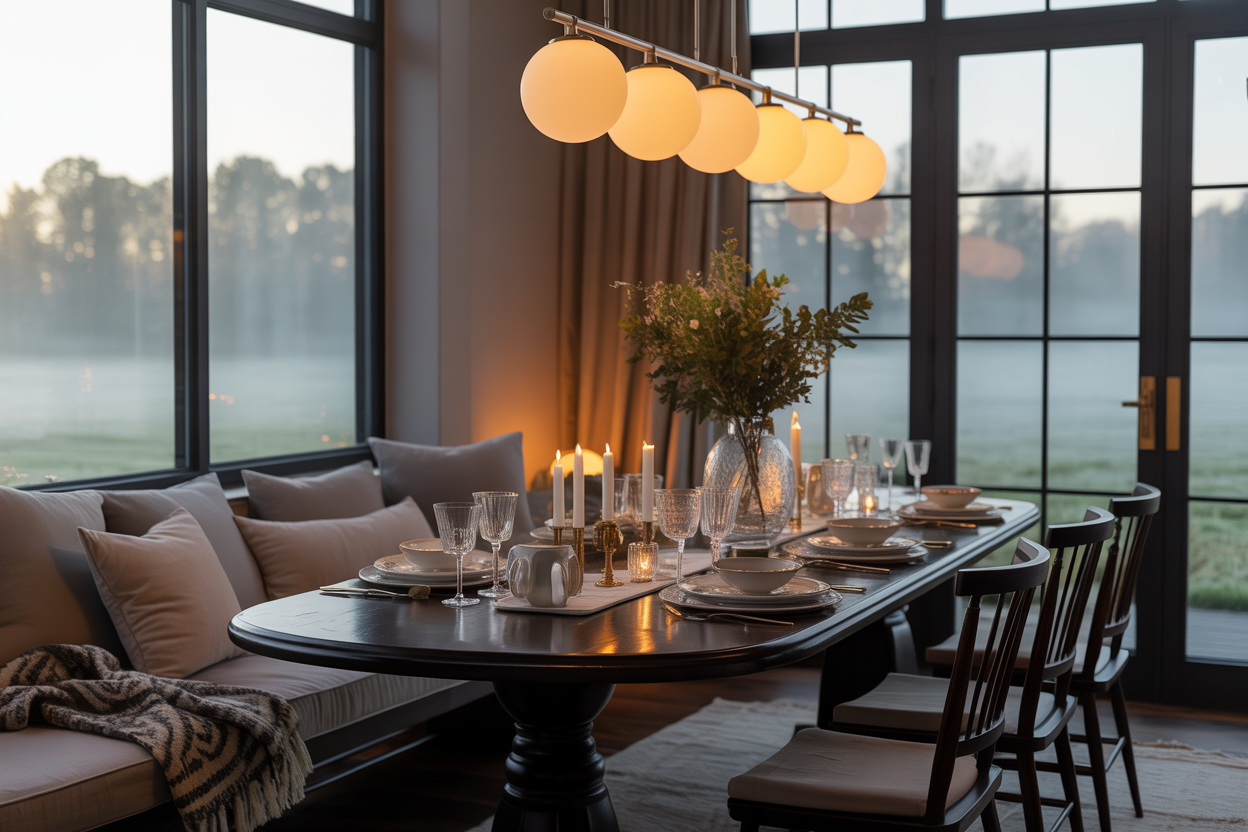
Nothing screams “budget renovation” quite like frosted glass globes that belong in a dollar store clearance bin. These milky white orbs instantly transform your dining room into a cafeteria waiting area.
You know the ones I’m talking about. Those lightweight plastic globes that feel hollow when you tap them. They cast that unflattering fluorescent-style light that makes everyone look like they need a vacation.
The worst offenders are the ribbed or textured versions that try too hard to look fancy. They fool absolutely no one with their faux-crystal appearance.
Quality glass globes have weight and clarity that cheap alternatives simply cannot replicate. The difference becomes glaringly obvious when guests notice your fixture swaying in the slightest breeze.
Your dining room deserves better than lighting that looks like it came from a contractor’s leftover bin. These globes might save you money upfront, but they’ll cost you credibility every time someone sits down for dinner.
15. Failing to use smart, dimmable systems for mood control
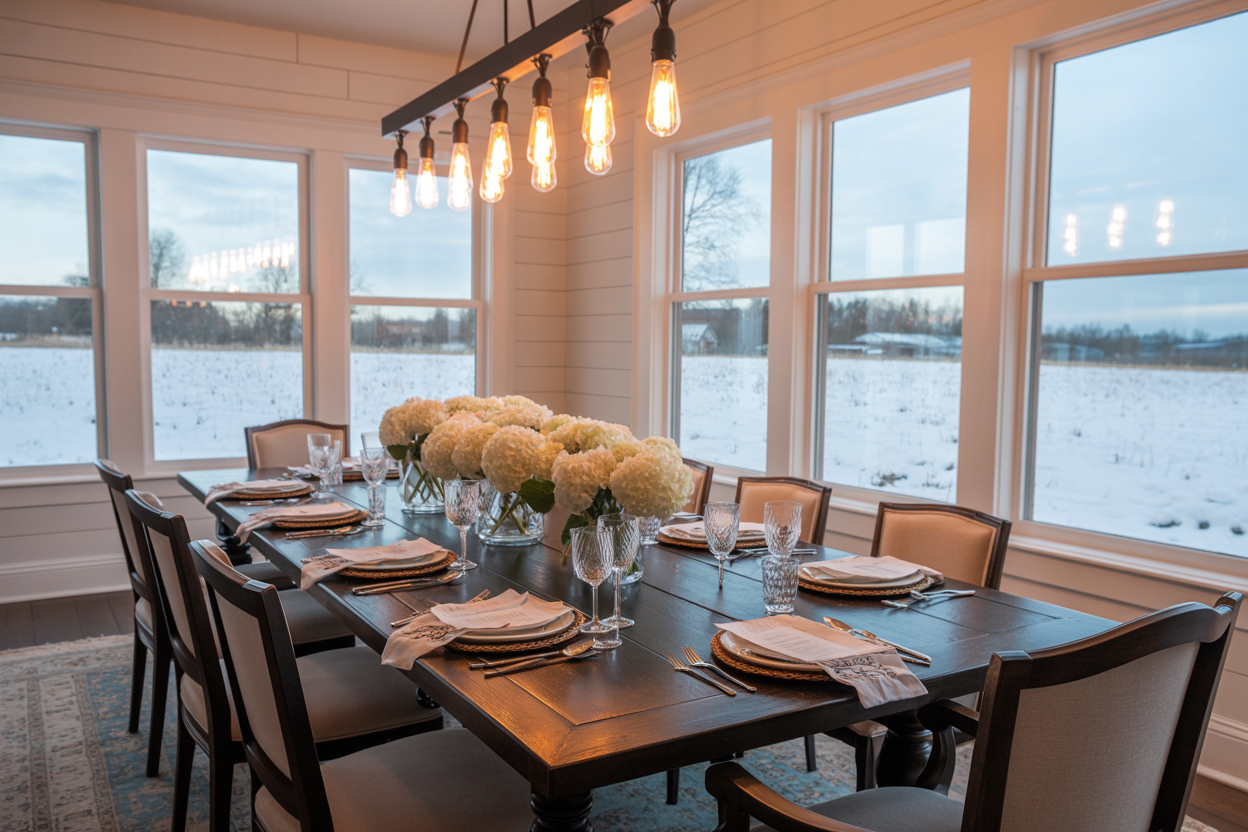
Your dining room lighting stuck on one brightness setting screams amateur hour. Fixed lighting kills the sophisticated ambiance that separates luxury homes from basic ones.
Smart lighting systems give you complete control over brightness and color temperature. You can shift from bright task lighting during cleanup to intimate dinner party glow with a simple tap.
The beauty of dimmable LED lights lies in their versatility. Morning coffee requires different lighting than evening wine service, yet most homeowners ignore this basic design principle.
Without dimming capability, you’re forcing guests to squint through overly bright meals or strain their eyes in dim conditions. Neither scenario feels luxurious.
Modern smart lighting can automatically adjust throughout the day, supporting your circadian rhythm while maintaining perfect ambiance. Your dining room should adapt to the occasion, not dictate it.
Installing non-dimmable fixtures in today’s market shows you either cut corners or didn’t think through the user experience. Both mistakes telegraph budget-conscious choices rather than thoughtful luxury design.
14. Chandeliers with too many crystals that catch dust but not admiration

You know that friend who overdoes it with jewelry? That’s exactly what happens when you hang a chandelier dripping with excessive crystals in your dining room.
Crystal chandeliers can add elegance to any space, but moderation is key. When every surface sparkles with dangling crystals, your fixture becomes a maintenance nightmare rather than a design statement.
Your guests won’t admire the sheer volume of crystals. They’ll notice the dust collecting on every surface and wonder when you last cleaned the thing.
These over-the-top fixtures require constant upkeep to maintain their sparkle. Each crystal needs individual attention, turning what should be a beautiful centerpiece into a weekly chore.
The real luxury lies in restraint. A well-designed chandelier with thoughtfully placed crystals creates drama without overwhelming your space.
Your dining room should feel sophisticated, not like a disco ball exploded overhead. Choose fixtures that enhance your room’s elegance rather than competing with it for attention.
13. Ultra-glossy brass fixtures that scream 1990s bathroom, not luxury.

You know that shiny, mirror-like brass finish that was everywhere in the ’90s? It’s back, and not in a good way. These ultra-glossy fixtures belong in a time capsule, not your dining room.
The problem isn’t brass itself—it’s the finish. Nostalgic 90s-styled bathroom ideas showcase exactly what we’re trying to avoid in modern luxury spaces.
Real luxury brass develops character over time. Unlacquered brass creates a rich patina that adds warmth and sophistication to any space.
Your guests will immediately recognize that overly polished brass look. It screams “builder grade” rather than “custom luxury.” The reflective surface creates harsh glare that competes with your carefully planned ambient lighting.
Quality brass fixtures have a subtle, matte finish or natural patina. They complement your dining room’s sophisticated atmosphere instead of dominating it with flashy shine.
Skip the bathroom-grade brass and invest in fixtures with authentic character. Your dining room deserves better than a 1990s bathroom makeover aesthetic.
12. Ignoring natural light and relying solely on artificial glare

You’re turning your dining room into a windowless bunker when you ignore the free luxury that sunlight provides. Natural light creates depth, warmth, and that coveted high-end atmosphere money can’t buy.
Blasting artificial lights during daylight hours screams amateur hour. Your guests will feel like they’re dining in a fluorescent-lit cafeteria rather than an elegant home.
Strategic integration of natural and artificial light requires balancing both throughout the day. Use natural light as your foundation, then layer artificial lighting for evening ambiance.
Heavy curtains or blinds that block daylight rob your space of its natural beauty. Consider sheer panels or adjustable window treatments that control light without eliminating it entirely.
Your dining room’s lighting should shift gracefully from day to night. Morning coffee should feel bright and energizing, while dinner needs intimate warmth.
Natural light affects mood and well-being in ways artificial lighting simply cannot replicate. When you ignore this powerful design element, you’re essentially throwing away a luxury feature that costs nothing to maintain.
Position mirrors strategically to bounce natural light deeper into your space. This simple trick amplifies the brightness without adding more fixtures.
11. Cluttered mixing of styles: mid-century modern meets cheap farmhouse from the bargain bin
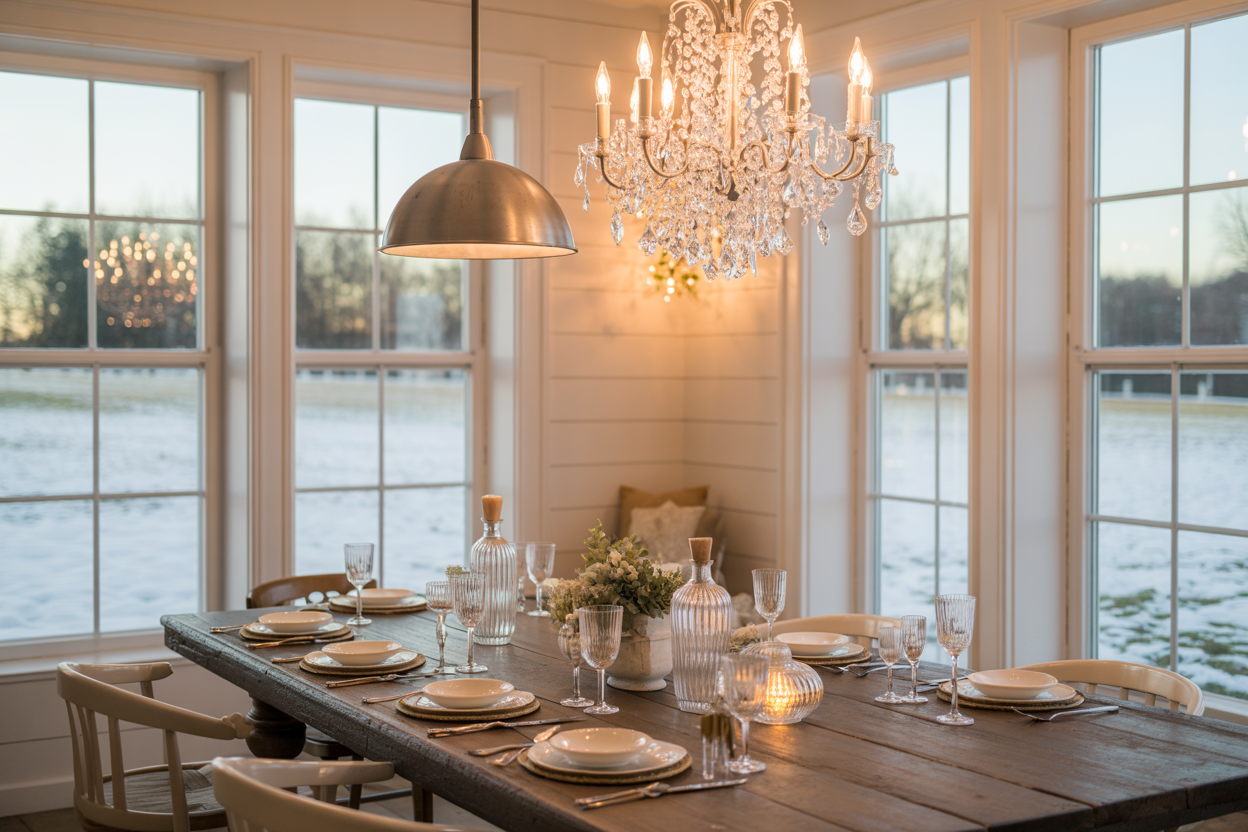
Your dining room lighting becomes a design disaster when you attempt to mix mid-century modern with farmhouse elements without understanding either style. The sleek lines of authentic mid-century pieces clash horribly with mass-produced “farmhouse” fixtures from big box stores.
You’re essentially creating visual chaos above your dining table. That cheap mason jar chandelier paired with a knock-off Sputnik pendant screams confusion rather than sophisticated design fusion.
Quality matters immensely when combining these styles. Your bargain bin farmhouse fixtures lack the craftsmanship and materials that make mixing mid-century and farmhouse styles work successfully.
The problem isn’t mixing styles—it’s mixing quality levels. Your expensive mid-century replica loses all impact when surrounded by flimsy faux-wood beams and plastic “vintage” bulbs.
Professional designers know that combining these aesthetics requires careful balance. You need consistent quality and thoughtful selection, not whatever catches your eye in the clearance aisle.
Your dining room deserves better than this stylistic free-for-all.
10. Track lighting that looks like a garage, not a dining room

Your dining room deserves better than the industrial track lighting you’d find in a warehouse. Those basic aluminum tracks with adjustable spotlights scream “utilitarian” rather than “elegant dinner party.”
The problem isn’t track lighting itself. Modern track lighting can enhance any room’s ambiance when chosen thoughtfully.
It’s the execution that kills your luxury vibe. Chrome tracks with harsh halogen bulbs create unflattering shadows on guests’ faces. The mechanical appearance dominates your ceiling instead of complementing your décor.
Your dining room lighting should create warmth and intimacy. Track lighting can be used in dining areas effectively, but it requires finesse.
Skip the contractor-grade options from the big box store. Choose tracks with refined finishes like brushed brass or matte black. Select fixtures with warm LED bulbs and diffused lenses.
The key is making the system feel intentional rather than industrial. Your guests should notice the beautiful lighting effect, not the mechanical track holding it all together.
9. Exposed Edison bulbs that feel try-hard rather than chic

Exposed Edison bulbs have been around since 1879, but today’s overuse has turned them into design clichés. Your dining room doesn’t need to look like every trendy restaurant from 2015.
The problem isn’t the bulbs themselves. It’s when you use them everywhere, thinking they automatically create atmosphere. Nothing screams “Pinterest board” like a chandelier dripping with fake vintage bulbs.
Exposed bulbs are often polarizing in lighting debates. They can be too harsh for intimate dining or produce inadequate light for practical use.
The luxury factor disappears when your lighting choice feels forced. Your guests shouldn’t wonder if they’re eating dinner or touring an industrial museum exhibit.
Smart bulbs now offer better solutions, allowing you to adjust from dim mood lighting to bright functional light with your phone. This flexibility beats the one-note performance of exposed Edison bulbs.
If you must use them, choose quality fixtures where the bulbs enhance rather than dominate the design.
7. Basic recessed lighting with zero dimmer options
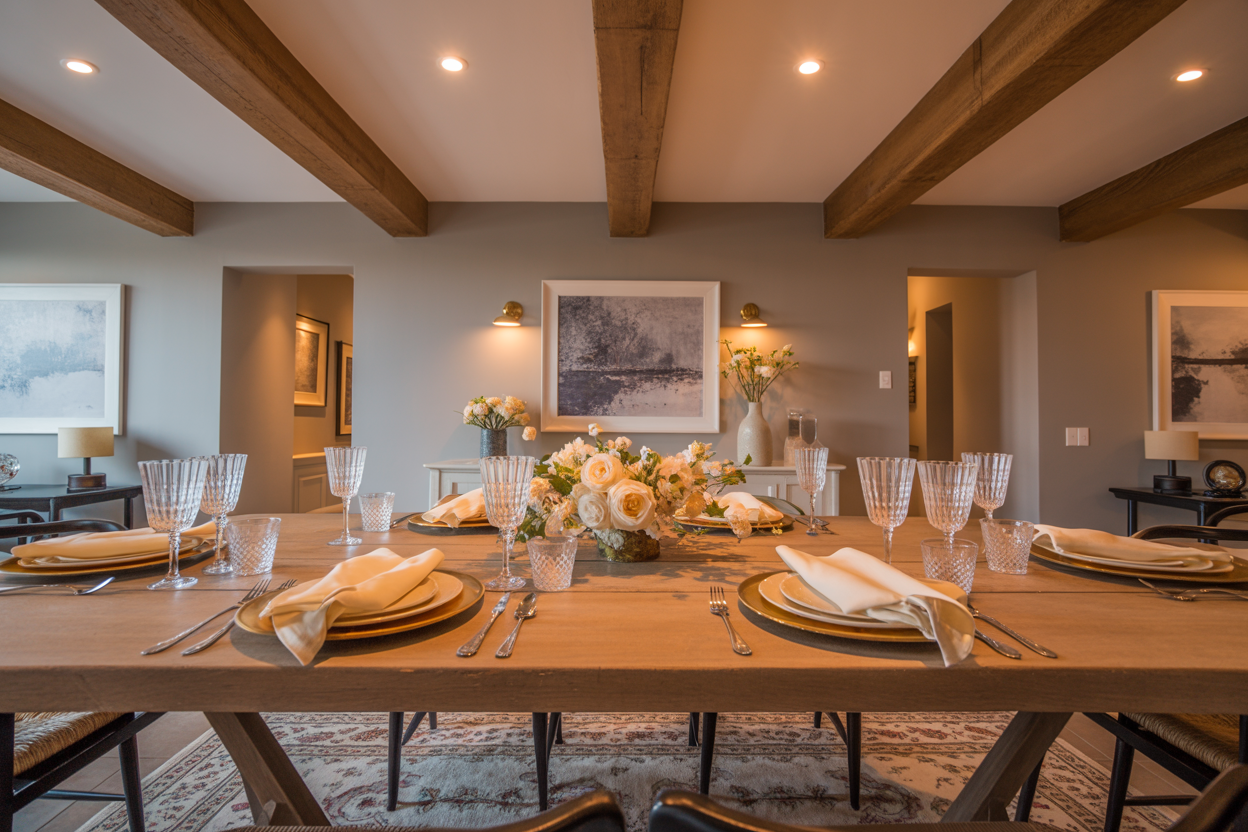
Your dining room’s recessed lights are about as inspiring as cafeteria lighting when they lack dimmer controls. You flip the switch and get blasted with full brightness or complete darkness.
This harsh on-off approach kills any chance of creating intimate dinner atmospheres. Recessed lighting for dining rooms can provide excellent illumination, but only when properly controlled.
Without dimmers, your guests feel like they’re eating under interrogation lights. The unforgiving brightness highlights every imperfection while making everyone squint at their salads.
Luxury dining spaces require lighting flexibility. You need soft ambiance for romantic dinners and brighter illumination for family game nights.
Basic recessed fixtures without dimming capability trap you in lighting limbo. Your beautiful dining table becomes a sterile workspace instead of an inviting gathering spot.
The solution involves upgrading to dimmer-compatible recessed lighting systems that give you complete control. Quality dimmer switches transform harsh overhead lighting into adjustable mood lighting.
Professional installations cost more upfront but deliver the lighting versatility that separates luxury homes from basic builder-grade spaces.
6. Using daylight bulbs in a space meant for evening ambiance

Your dining room at 6 PM shouldn’t feel like a hospital operating room. Yet countless homeowners install crisp daylight bulbs and wonder why their dinner parties feel clinical rather than cozy.
Daylight bulbs emit harsh, cool light that mimics midday sun. This works brilliantly for task lighting in kitchens or home offices. But in your dining room? You’ve just murdered the mood.
The impact of daylight bulbs on dining room ambiance is significant and rarely positive for evening entertainment. Your guests will look washed out, food appears unappetizing, and intimate conversation becomes impossible under that stark glare.
Lighting choices drastically change a room’s psychological response. Cool daylight temperatures energize and increase focus – exactly what you don’t want during a relaxing dinner.
Smart designers know that warm lighting creates the perfect dining ambiance. Save those daylight bulbs for your workshop.
Your dining room should whisper luxury, not shout efficiency. Choose warm-toned bulbs that make everyone look their best and transform meals into memorable experiences.
5. Pendant lighting hung so low it hits your wine glass every time

You’ve seen this disaster at dinner parties where guests duck under light fixtures like they’re navigating a submarine. The pendant lights hang so low that raising a wine glass becomes an Olympic sport.
Pendant lights in dining areas should typically be positioned 30 to 36 inches above the table to provide adequate lighting without obstructing views. Yet homeowners consistently ignore this rule, creating an obstacle course above their dining surface.
Your beautiful statement pendant becomes a conversation killer when guests can’t lift their arms without fear of collision. The fixture that was meant to create ambiance instead creates anxiety.
If pendant lights are hung too low, they can throw the room off balance and look out of place. More importantly, they turn every meal into a game of limbo nobody asked to play.
The irony is thick here. You invested in gorgeous pendant lighting to elevate your dining experience, but hung it so low it literally prevents anyone from elevating anything else.
4. Ignoring layered lighting—ambient, task, and accent all crammed into one light source.

Your dining room chandelier might be gorgeous, but asking it to do everything is like expecting your hammer to be a screwdriver too. It’s going to disappoint you.
Layered lighting splits between three distinct types: ambient, task, and accent lighting. Each serves a specific purpose in creating sophisticated illumination.
When you rely on one central fixture, you’re missing the depth that luxury spaces require. That single chandelier creates harsh shadows and flat lighting that screams “builder grade” rather than “custom design.”
Your dining room needs ambient lighting for overall brightness, task lighting for specific activities like reading menus, and accent lighting to highlight artwork or architectural features.
Without proper layering, even expensive fixtures fall flat. The light becomes one-dimensional, eliminating the visual interest that makes upscale spaces feel intentional and curated.
Smart designers know that combining all three lighting layers creates the kind of sophisticated atmosphere that makes guests assume you hired a professional. Your single overhead fixture, no matter how pricey, simply can’t achieve this level of refinement.
3. Cold white bulbs that suck the warmth out of any room.
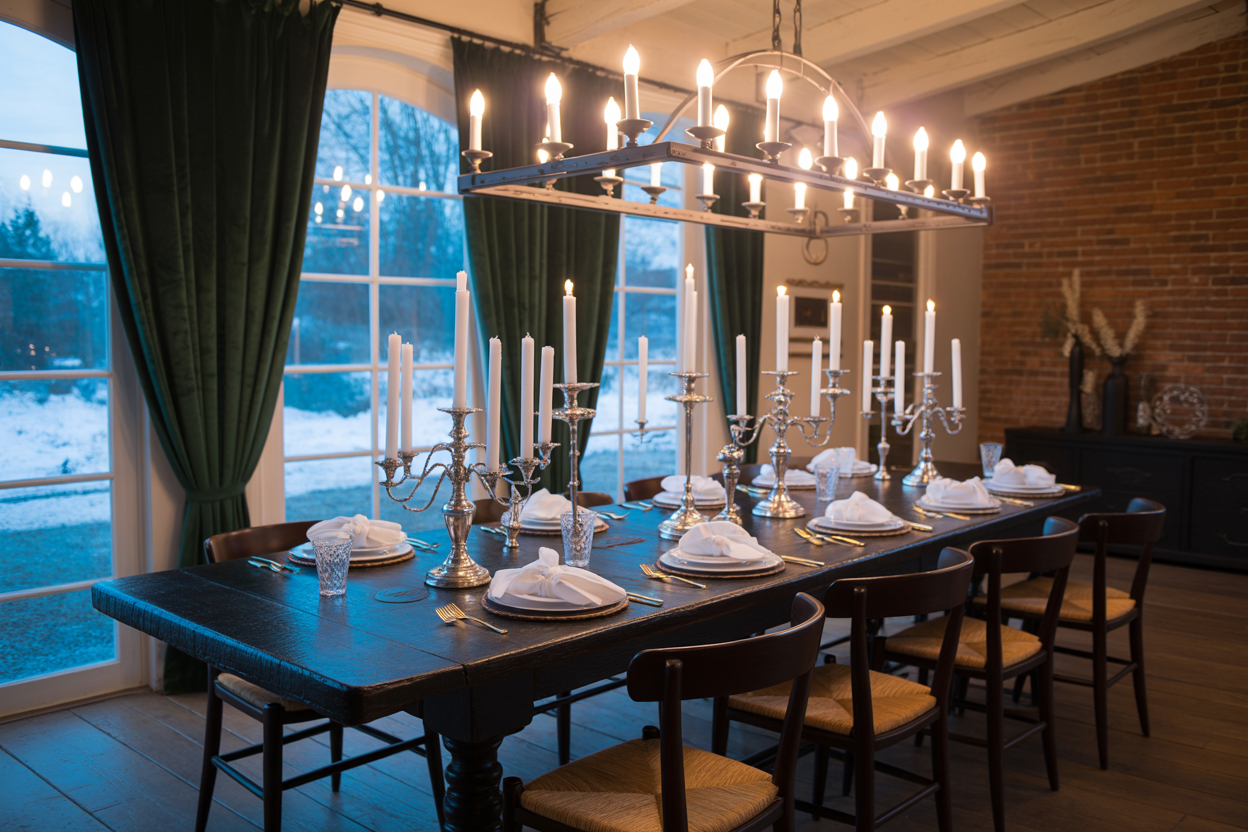
Nothing kills a luxury dining room vibe faster than cold white bulbs blazing overhead like a hospital operating room. You might think brighter is better, but cool white bulbs consisting of 5000-6200 Kelvins will make your beautiful dining space feel sterile and uninviting.
Your guests won’t want to linger over dinner when harsh lighting makes everyone look washed out and tired. The blue undertones in cool white bulbs create shadows that emphasize imperfections rather than the warm ambiance you’re trying to achieve.
Warm white lighting between 2700-3200 Kelvins creates the golden glow that makes skin tones appear healthy and food look appetizing. This is why upscale restaurants never use cool white bulbs in their dining areas.
You probably wouldn’t want daylight over the dining room table for good reason. Save those bright bulbs for task lighting in kitchens and bathrooms where you actually need to see clearly.
2. Cheap plastic chandeliers with zero character or heft.
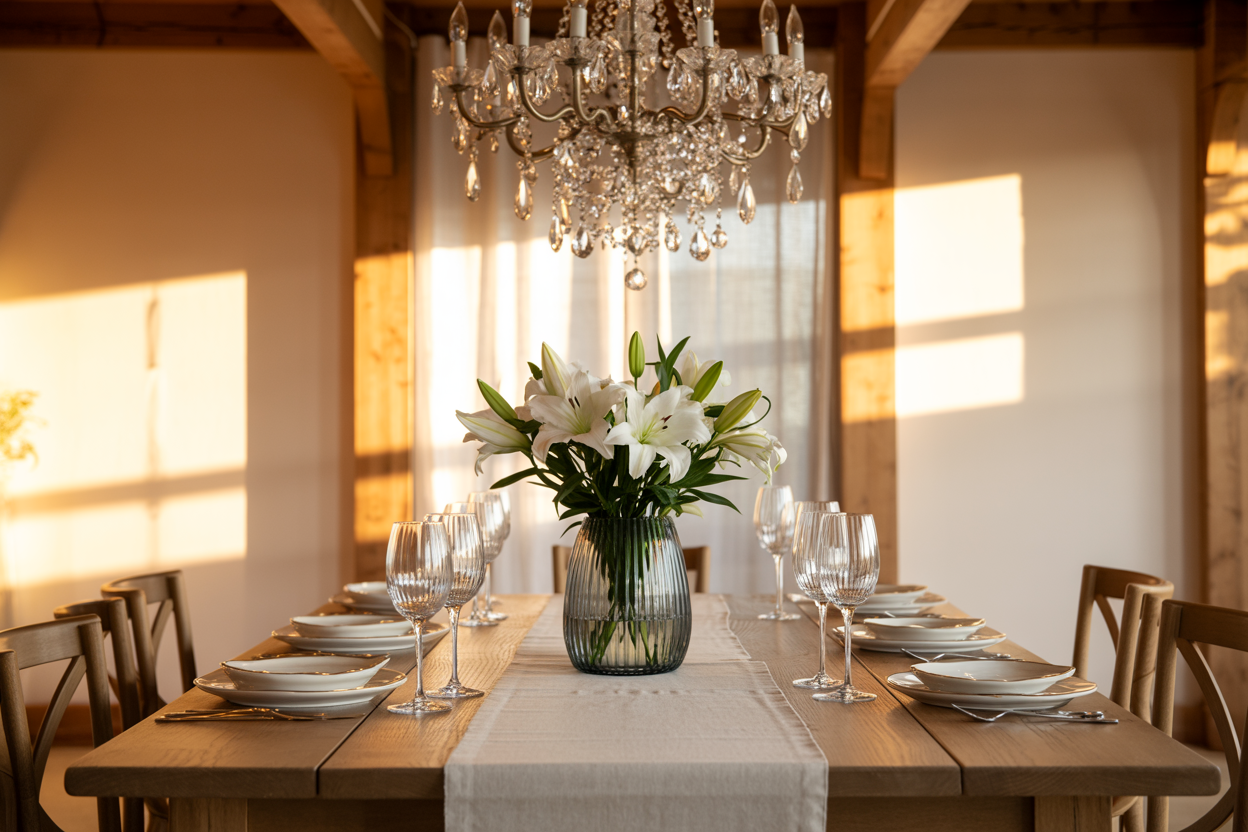
Nothing screams “I shopped the clearance aisle” quite like a plastic chandelier swaying overhead. These lightweight imposters fool no one with their hollow construction and flimsy arms.
Real chandeliers have presence. They command attention through substantial materials like crystal, metal, or quality glass. When your dining room fixture weighs less than a bag of groceries, you’ve missed the mark entirely.
Plastic chandeliers often feature obvious molding seams and that telltale synthetic sheen. The finish wears off within months, revealing the cheap material underneath.
Your guests will notice the difference immediately. Quality fixtures have weight, proper balance, and materials that catch light beautifully. Plastic versions lack this fundamental character.
The installation process reveals their true nature too. While proper chandelier hanging requires careful consideration of weight and support, plastic fixtures feel insubstantial in your hands.
Skip the discount plastic options entirely. Your dining room deserves a fixture with actual substance and craftsmanship that enhances rather than diminishes your space’s luxury appeal.
1. Overly bright LED fixtures that scream ‘hospital corridor’ instead of ‘fine dining.’

Nothing kills the mood faster than dining under lighting that belongs in a medical facility. You’ve seen those harsh, clinical LED fixtures that make your beautiful dining room feel like you’re about to get your blood pressure checked.
The problem isn’t LED technology itself. It’s choosing fixtures with the wrong color temperature and intensity. Those blazing 5000K daylight bulbs might work great for hospital corridors, but they’ll turn your dinner party into an interrogation.
Your guests shouldn’t need sunglasses to enjoy their meal. When the lighting is so bright it washes out skin tones and makes food look unappetizing, you’ve crossed into institutional territory.
The stark, uniform illumination that hospitals require for safety is the exact opposite of what creates dining ambiance. You want warmth, not the sterile brightness of a medical examination.
Consider this your wake-up call. If your dining room lighting makes people squint or feel like they’re in a cafeteria, it’s time for a change. Your home deserves better than borrowed hospital aesthetics.






